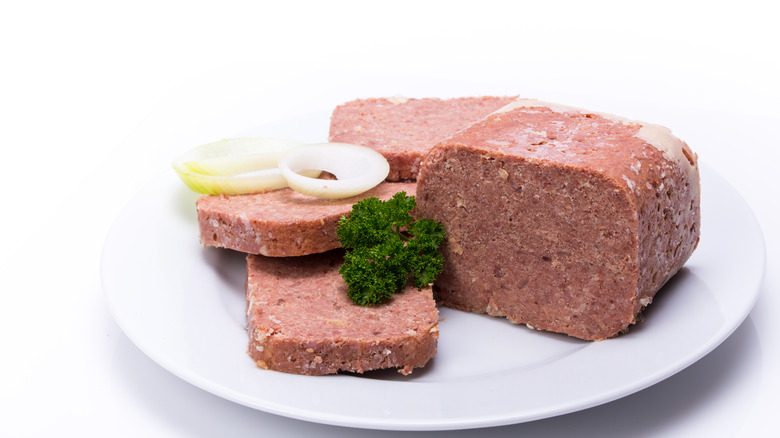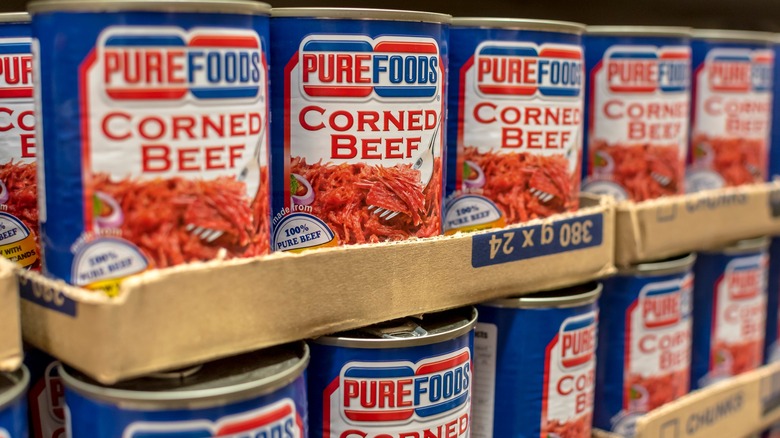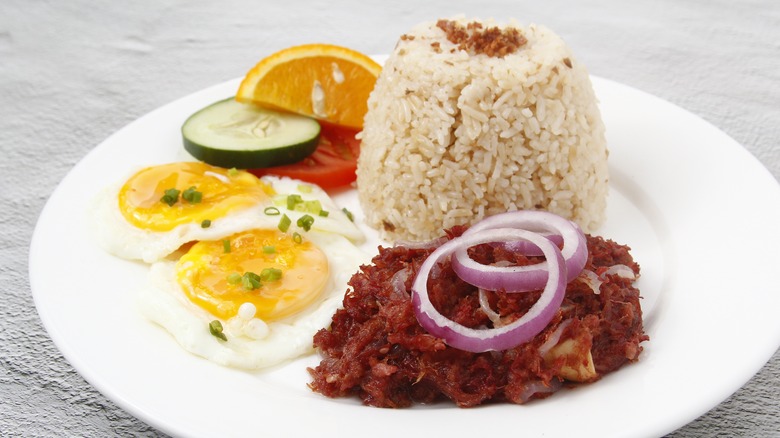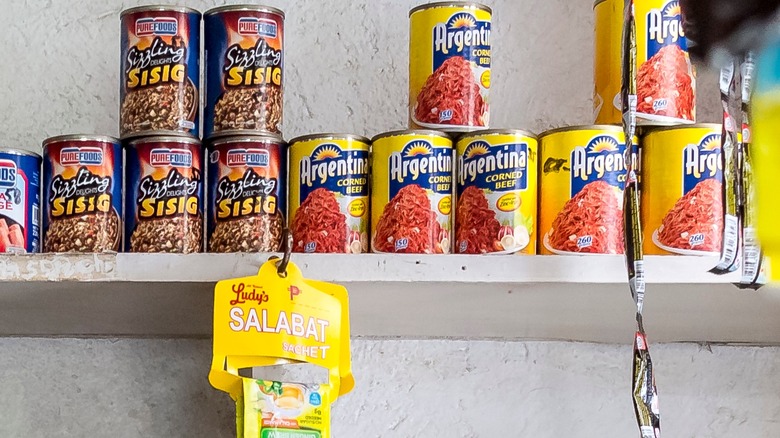Canned Corned Beef Is Arguably Most Popular In This Country
Most of us may know of corned beef as the treat we enjoy during St Patrick's Day. But beef brisket served with cabbage isn't the only dish that was given the named "corned beef." The term — along with the dish — was actually invented by the British in the 17th century.
According to Smithsonian, "corned beef" was named in part for the salt which was used to cure beef, which were described as "the size of corn kernels." These pieces of cured and salted beef came from Ireland, where cattle was plentiful and salt was cheap. And it was a treat enjoyed not just in Britain, but in Europe and the New World, too. Corned beef was also a hit in America, where Food Timeline says making salt beef was both economical and effective.
By the 1800s, salt beef could be packed into tin-coated iron cans to become canned corned beef, thanks to a method patented by Englishman Peter Durand, per Britannica. Ten years later, this technology was being used by manufacturers Donkin & Hall to make canned meat to sell to the Royal Navy, per Food Timeline. These cans, per Taste, became known as "bully beef," which the British army finally discontinued as a ration in 2009, per The Telegraph.
How corned beef made it to the Philippines
The idea of distributing canned meat to servicemen as part of a ration pack also became popular in the United States. That came in handy during the Spanish-American War, when fresh beef supplies had become compromised due to poor storage. Troops ended up having to rely on corned beef, which was described as "stringy, gristly, unpalatable, and at times nauseating," according to the Bulletin of the History of Medicine.
It was likely also during this period when the Philippines, which was also part of the front line of the Spanish-American War, had its first encounter with canned corned beef. Taste says the American occupation of the Philippines saw canned food sent from the U.S. mainland to colonial personnel, as they were worried about what would happen if the officials were to have "native food."
The canned foods that were seen as "must-haves" for American families made their way into the homes of the country's elite, where they were treated as a luxury. As Taste writer Elaine Castillo points out, "The way Filipinos took on canned food ended up appropriating, embellishing, and then ultimately normalizing — indeed, nativizing — an unloved, utilitarian piece of colonial kit." That's how corned beef (which Filipinos also call "carne norte" or "meat from the north" per AtoZfoodnames) came to become such a hit in the Philippines. There, it's so popular it could well be consumed in greater amounts than any other country, per A Little Bit Human.
Corned beef is the star ingredient in breakfast dishes
Today, corned beef and its canned cousin, Spam, which became popular in the Philippines after World War II, per SBS, have become breakfast items that many households in the country can't do without.
While corned beef is almost always prepared as corned beef hash in the United States, the same cannot be said of the protein in the Philippines, where it is mainly served for breakfast as "corned beef silog." In this dish, corned beef is fried with onion and garlic, and its flavor amped up with beef broth, before it is served with classic Filipino garlic fried rice and a fried egg, per Panlasang Pinoy.
There are other ways of preparing corned beef, too. It can be cooked so it is reminiscent of corned beef hash and then served on top of steaming white rice, per Kawaling Pinoy. Corned beef even serves as a star ingredient for a modern take on a traditional noodle soup dish, per Panlasang Pinoy. Bring on the Spice recommends preparing corned beef with tomato, lemon juice, and habanero pepper to create a variation of ginisang, or fried corned beef. This can either be served with garlic rice or another Filipino classic, the tiny buns known as pandesal.
Corned beef has spawned a new generation of canned corned meats
The popularity of corned beef in the Philippines has led food processing firms to "corn" ingredients other than beef and buffalo, giving rise to "corned tuna," which features tuna which is preserved using the same methods corned beef would be, per Yummy.
As an alternative to corned beef and bacon, there is also "corned lechon," which is a canned version of the country's favorite roast pork dish, per Flavours of Iloilo. Then, there's corned chicken, which is made with chicken breasts, per PCV.
Corned beef isn't any less desirable for those who might have left the Philippines to make their homes in America, or in Australia. Some continue to cook corned beef because they yearn for the taste of home; others keep it as a pantry staple for more practical reasons. "The tinned foods — Spam, corned beef — were our staples because they're easy to cook, the kids can make them themselves," one writer says, via SBS.



